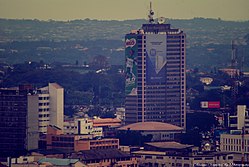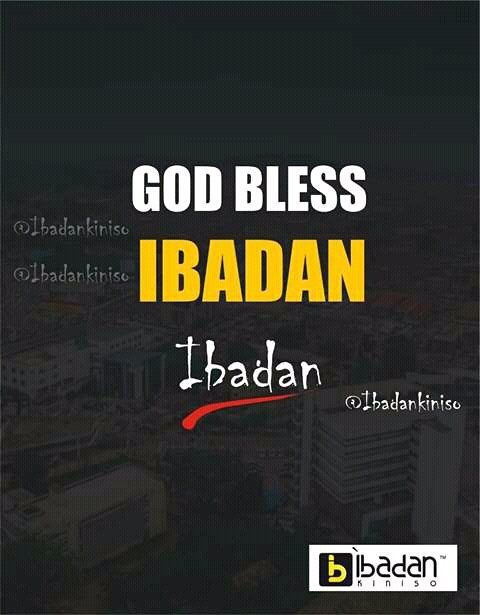History of Ibadan

Ibadan (Yoruba: Ìbàdàn) is the capital of Oyo State, Nigeria and the most populous city in the state with a population of over 3 million. It is the third most populous city in Nigeria, after Lagos and Kano; it is the country's largest city by geographical area. At the time of Nigeria's independence in 1960, Ibadan was the largest and most populous city in the country, and the second most populous in Africa after Cairo.
Ibadan
Nickname(s): Ile Oluyole Ilu Ogunmola
Location in Nigeria

History
Ibadan came into existence in 1829, during a period of turmoil that characterized Yorubaland at the time. It was in this period that many old Yoruba cities such as old Oyo (Oyo ile), Ijaye and Owu disappeared, and newer ones such as Abeokuta, new Oyo (Oyo atiba) and Ibadan sprang up to replace them.[3] According to local historians, Lagelu founded the city, and was initially intended to be a war camp for warriors coming from Oyo, Ife and Ijebu.[4] As a forest site containing several ranges of hills, varying in elevation from 160 to 275 metres, the location of the camp offered strategic defence opportunities. Moreover, its location at the fringe of the forest (from which the city got its name) promoted its emergence as a marketing centre for traders and goods from both the forest and grassland areas.
In 1852 the Church Missionary Society sent David and Anna Hinderer to found a mission. They decided to build the mission and a church in Ibadan when they arrived in 1853.[5]
Ibadan thus had initially began as a military state and remained so until the last decade of the 19th century. The city-state also succeeded in building a large empire from the 1860s to the 1890s which extended over much of northern and eastern Yorubaland. It was appropriately nicknamed idi Ibon or “gun base”, because of its unique military character.
Unlike other Yoruba cities with traditional kingship institutions however, In Ibadan, the warrior class became the rulers of the city as well as the most important economic group. According to HRH Sir Isaac Babalola Akinyele, the late Olubadan (king) of Ibadan (Olu Ibadan means 'Lord of Ibadan'), in his authoritative book on the history of Ibadan, Iwe Itan Ibadan (1911), the first city was destroyed due to an incident at an Egungun (masquerade) festival when an Egungun was accidentally disrobed and derisively mocked by women and children in an open marketplace full of people. The then Alaafin of Oyo had ordered the old city destroyed for the act. Lagelu was by now an old, frail man; he could not stop the destruction of his city, but he and some of his people survived the attack and fled to a nearby hill for sanctuary. On the hill they survived by eating oro fruit and snails; later, they cultivated the land and made corn and millets into pap meals known as oori or eko, which they ate with roasted snails. They improvised a bit by using the snail shells to drink the liquefied eko. Ultimately, Lagelu and his people came down from the hill and founded another city, called Eba'dan.
The new city instantly grew prosperous and became a commercial nerve centre. Shortly afterwards, Lagelu died, leaving behind a politically savvy people and a very stable community. The newly enthroned Olubadan made a friendly gesture to the Olowu of Owu by allowing Olowu to marry his only daughter, Nkan. A part of Ibadan was historically an Egba town. The Egba occupants were forced to leave the town and moved to present-day Abeokuta under the leadership of Sodeke as result of their disloyalty. Ibadan grew into an impressive and sprawling urban center so much that by the end of 1829, Ibadan dominated the Yorùbá region militarily, politically and economically.
The military sanctuary expanded even further when refugees began arriving in large numbers from northern Oyo following raids by Fulani warriors. After losing the northern portion of their region to the marauding Fulanis, many Oyo indigenes retreated deeper into the Ibadan environs. The Fulani Caliphate attempted to expand further into the southern region of modern-day Nigeria, but was decisively defeated by the armies of Ibadan in 1840, which eventually halted their progress. The colonial period reinforced the position of the city in the Yoruba urban network. After a small boom in rubber business (1901-1913), cocoa became the main produce of the region and attracted European and Levantine firms, as well as southern and northern traders from Lagos, Ijebu-Ode and Kano among others. The city became a major point of bulk trade. Its central location and accessibility from the capital city of Lagos were major considerations in the choice of Ibadan as the headquarters of the Western Provinces (1939) which ranged from the northernmost areas of Oyo State to Ekeremor, Bomadi and Patani, which were regions transferred from the old Delta province in the Old Western region and later Mid-west to the old Rivers state and later Bayelsa, in the redistricting of Nigeria carried out by the Yakubu Gowon administration shortly before the Nigerian civil war
Colonial Ibadan
In 1893, Ibadan area became a British Protectorate after a treaty signed by Fijabi, the Baale of Ibadan with the British acting Governor of Lagos Colony, George C. Denton on 15 August.[7] By then, the population had swelled to 120,000. The British developed the new colony to facilitate their commercial activities in the area, and Ibadan shortly grew into the major trading center that it is today.
Hi! I am a robot. I just upvoted you! I found similar content that readers might be interested in:
https://en.wikipedia.org/wiki/Ibadan